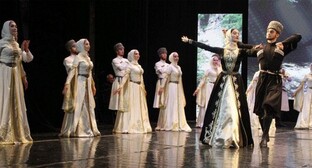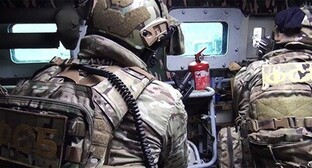14 October 2003, 20:40
Caucasian Knot: developing information partnership
The emergence
In 2000 the Open Society Institute (OSI) announced launching a new program called Hot Spots. How to help Chechnya's military action victims and refugees? How to reduce interethnic tension in a series of regions in the North Caucasus? The Hot Spots Program was aimed at solving these and other social problems in 2000-2002, for which the Board of the Civil Society Program developed an individual plan of action (see: http://www.osi.ru). First steps of the program were aimed at creating conditions for providing the Russian citizenry with objective information about the situation in the North Caucasus and carried out in a series of informational projects. In the long-term outlook, the program took the line to develop dialogue in the society and strengthen the role of public structures in the region. By supporting specific peacekeeping projects of various organizations in the North Caucasus, the program began to unite structures interested in the positive development of the region. Funding on a competitive basis enabled supporting a number of various local practical initiatives, boosting some nonprofit organizations' potential and assisting in solving specific tasks. Hot Spots is presently one of the key lines of the OSI's Civil Society Program.
As first regional projects of the program were funded, the issue was raised of the need for information support for them. Often inconspicuous against the background of television news and Society sections in print media, results of operating on the lines of the projects remain beyond the attention of the public in some or other region; organizations' experience in solving similar problems is not discussed; and victories do not become the property of the entire community of nongovernmental structures. At the same time, the organizations would like to be conspicuous and many are prepared to share methods and responsibly present their performance. Workshops and meetings do not exhaust opportunities of organizations' contacts and they often do not provide efficient leverage for contacts with a wider audience.
A series of expert tours of the region helped study attempts of creating information networks that would feature initiatives of the regional nonprofit sector. One objective difficulty was to establish a regular information flow: many projects were of a local nature, information was slowly updated and the culture of communication and information exchange in the sector was undeveloped. Besides, competition for sponsored provision of information services was high enough, so it often limited the area of cooperation. Even within authoritative web structures (for example, working groups on conflict settlement) the level of media performance until recently remained low and joint media projects were only in the discussion stage. At the same time, however, such steps were taken, so they may and should be viewed as response to the acute need to strengthen media channels in the North Caucasus's developing nonprofit sector. Considering that, planning its operation for the long-term outlook, Hot Spots intended to support in the future at least 200 projects of various organizations, there was a need for an information strategy to go along with project activities. What's to be done: encouraging small nonprofit organizations to create their own web pages; searching for opportunities to support already existing media projects in the sector; or developing a new mechanism that would make it possible to consider interests of wide user circles - from ordinary nonprofit sector workers to experts and professionals working in the North Caucasus? Requirements to the efficiency of investments in projects dictate quite rigid terms of funding and make one search for optimal schemes to promote the achieved results. Experts and program workers discussed various options of media performance and chose an approach that was probably one of the most complicated and quite innovative for the OSI's current programs - creating a special information resource cooperating with the program and based on a strong NGO and open partnership principles. The Caucasian Knot Project (hereinafter "the Project") became such a resource.
Specifics of the Caucasian Knot Project
What do the specifics of the program-proposed approach consist in? I will try to briefly outline the key parameters proposed in the stage of drawing up the concept of the Project:
- the Project should provide objective, considered information about the situation in the North Caucasus;
- the Project must not feature the standpoint of one expert or an expert group; it should provide an idea of the scope of existing assessments of some or other event or activity;
- the Project should rest on public initiative;
the Project cannot provide exhaustive information about every aspect of social life in the North Caucasus and Russia with regard to the events in the North Caucasus (at least on account of limited resources), but it should focus on the key aspects of social development which public structures can influence; - the Project should become a tool to link different structures prepared for cooperation based on the key values of an open society;
- the Project should find its own niche among media resources covering the situation in the North Caucasus.
The backbone elements for creating the new media resource were the principle of partnership and using the integrated effect of the combined performance of the Project's media components.
The concept of Caucasian Knot was developed by the following organizations: the OSI, the Human Rights Institute, Memorial and Panorama. The organizations had had experience of bi- and trilateral cooperation, but they first joined each other to discuss a partnership project. Common to all the organizations is their fundamental commitment to strengthening democracy in Russia and concern about developments in the North Caucasus. Each of the mentioned organizations has experience of operating in that region, cooperates with high-level professionals and is interested in reinforcing the public sector potential in the North Caucasus considering it a serious resource of social changes. Joining forces to develop the concept and correct the Project in its emergence stage, to my mind helped substantially boost its potential and make its structure and content more defined and focused on the real needs of users and participants.
Hot Spots suggested linking the Project's operation directly to: 1) the need for information exchange experienced by grant recipient organizations and program experts; 2) attracting the attention of both the Russian and international public to problems and needs of the region; and 3) developing a network of organizations sharing the values of an open society in the Caucasus.
The organizations were provided with a media resource for exchanging ideas and experience; contacts; presentation of their activities; and discussions. At the same time, the program equally promotes the achievements of all nonprofit organizations prepared to cooperate with the Project by posting information on the organizations' performances in a constantly updated database. The advanced aspects of featuring the project performances of various organizations to my mind are linked to active work on promoting the media resource on the whole, both in the public and other sectors. By utilizing the opportunities of the Project's website, donating structures can learn about regional organizations' initiatives and about active organizations. Preparing this database led to checking large data volumes and revealing a lot of inoperative organizations in the North Caucasus that nevertheless were present in databases of nonprofit organizations transferred to the program and the Project in a series of expert tours of the Caucasus. Journalists, in turn, can take interest in specific initiatives or pick out information about daily events in the regions and make use of the inquiry system to draw up some or other topical files. Public organization activists or students can get information for their practical activities or educational tasks.
It should separately be noted information about events in the public sector is received directly from the region, so all aspects of public life are reflected on the Project's website - from small activities of nonprofit organizations to larger-scale events. At the same time, the Project is not only focused on registering problems, but also on success stories and achievements in the region's everyday life, in many respects facilitated by efforts of various nonprofit organizations.
Advantage of cooperating with a network organization
It is important the Project is carried out on the basis of a branched network organization - the international society Memorial that has experience of regional network coordination utilizing various leverage of network communication - from a newspaper and specialized information bulletin to Internet media. It is fundamental that Memorial has serious experience of work in conflict areas, carries out educational programs and historic-educational projects on tolerance and peacekeeping and possesses longstanding experience of conducting international programs.
It is the combination of the abovementioned properties with the readiness to interact on terms of open partnership that made it possible to develop and launch the organizational scheme of the Project and abandon the quite narrow operation principle of traditional information sites chiefly based on a paid regional correspondent network. And it was the operation of public sector structures that was to be the source of information, while the need to share it with colleagues, to make one's own contribution to the common cause was to become the key organizing factor in shaping the informational logistics.
In many respects, meetings of experts within the scope of Hot Spots' regional consultations initiated in 2001 contribute to solving this task. The first meeting was held in Moscow in early 2001 by the Human Rights Institute in association with Caucasian Knot and Nonviolence International. The second meeting was part of the OSI's Humanities Festival in Nalchik, the Kabardino-Balkar Republic. The third meeting on issues of developing comprehensive peacekeeping programs took place in Moscow in December 2001. Regular consultations with regional experts allow correcting the Project's operation, prioritizing in media performance, expanding contacts on the site and exchanging assessments of the current situation in order to shape the selection of analysis files.
Experience of international cooperation enabled Memorial in the second stage of the Project's operation to extend media partnership to other regions in the Caucasus without being confined to the North Caucasus alone. Along with Caucasian Knot, Hot Spots took part in a trip to Georgia to publicize the Project and exchange experience of media work with Georgian nonprofit organizations. The experience of Caucasian nonprofit organizations may serve as a basis for interaction and the future development of international projects within the scope of Caucasian Knot. And this is another advanced aspect of the Project which makes it possible not only to promote "objective information provision" in a greater number of regions, but also carry out comparison and get introduced to the performance of organizations that are practically not covered by Russia's existing public sector media resources.
Prospects for developing partnership
In its development, the Caucasian Knot partnership in many respects aims at the long-term outlook. One may say the Project's methods of work are on the whole becoming "model" for organizing a similar regional media resource on public sector life. Principles of the Project's operation not only can be used by individual organizations interested in conducting media work, but also by groups of organizations - networks as we call them today - that solve common problems within the scope of their widespread operation.
The Project's information dimension is organized in such a way that events in public sector life featured in the News section are reflected in the Project's archive that presently already has an independent value for public sector researchers, analysts and journalists.
In carrying out various projects aimed at the active involvement of civil structures such as public organizations, independent media, culture institutions and so on in solving problems of the North Caucasus, Hot Spots tries to establish information exchange between participants in the program using Caucasian Knot's opportunities as an open media platform. With a view to this, the program facilitates strengthening Caucasian Knot's mediation resource. This problem is solved by funding trips of Caucasian Knot workers to the region; connecting to other partnering structures working on the program, in particular, on issues of organizing media coverage of comprehensive peacekeeping programs; inviting Caucasian Knot workers to participate in various working meetings within the framework of the program; and so on. In prospect, the program sees Caucasian Knot as an active resource of information support for the sector's most important and interesting activities in the North Caucasus.
The Project's editorial staff actively cooperates with Hot Spots on developing manuals for nonprofit organizations interested in organizing media operation. Special manuals have been drawn up for nonprofit organizations that would like to post files on their performance in the key sections of the Project's website. Some files on conducting discussions in public sector print and e-media have been drawn up and proposed for discussion and a media operation workshop for young interns from Dagestan has been developed. Partnership on the Project enables Hot Spots not only to organize a media platform for grant recipients, but also to share methods developed in the process of realizing the Project with grant recipient organizations and the entire wide circle of concerned parties in the sector.
What should Caucasian Knot be like in prospect? Of course, one would like to hope the Project's operation will lead to shaping an efficient system to obtain and process information for the News section with optimized spending. This can be achieved by investing in the development of regional organizations' information potential; establishing efficient coordination of the extant information flows in the sector; and strengthening the media work in the region and on regional topics via Caucasian Knot. The Project's analytical and educational elements should also be deployed via the further development of contacts with the network of regional experts actively cooperating with Hot Spots. Featuring the most interesting research files on various aspects of the region's life is worth developing, too.
I will not focus individually on tasks of covering the operation of the OSI's grant recipient organizations, which is part of Memorial's obligations as partner in the Project. I hope the Project will serve to summarize the public sector activity initiated by the OSI; information about this is accumulated in Caucasian Knot's various sections.
To my mind, Caucasian Knot's educational work should be continued along the line of organizing and conducting teaching work on public information provision for those regional organizations in the North Caucasus that intend to improve the quality of their media operation. Resting on Memorial's resources, Caucasian Knot can provide public organizations not only with its media platform, but also show them the ways to develop other forms of media work within the scope of an organization or a union of organizations. Caucasian Knot can summarize both the experience of creating and developing a topical information resource based on an organization and - in cooperation with the Civil Society Program - the entire experience of partnership on media coverage of an individual charitable program.
All the abovementioned aspects can fully be realized while expanding cooperation with international organizations operating in the region; actively working among donating organizations; and strengthening relations with professional news agencies. In 2002 the Civil Society Program initiated transition from partnership within the framework of one specific Project to a series of sponsored programs carried out in educational and media cooperation with Caucasian Knot along the line titled "Objective coverage and analysis of the situation in conflict areas." The program also plans to expand cooperation with Caucasian Knot when organizing competitions for public sector network structures that aim at improving media operation.
Important for me are "open partnership" principles such as mutual assistance and moral support and seeking to step up the combined resource of the union. Partnership demands spending, but it pays back that sort of social effect which is only possible when many join forces. I hope the partnership of Civil Society with Caucasian Knot will develop and this experience will be of use to the public.
Moscow, July 2002
Author: Elena V. Kovalevskaya, sociologist, Civil Society Program Director, Open Society Institute-Russia




